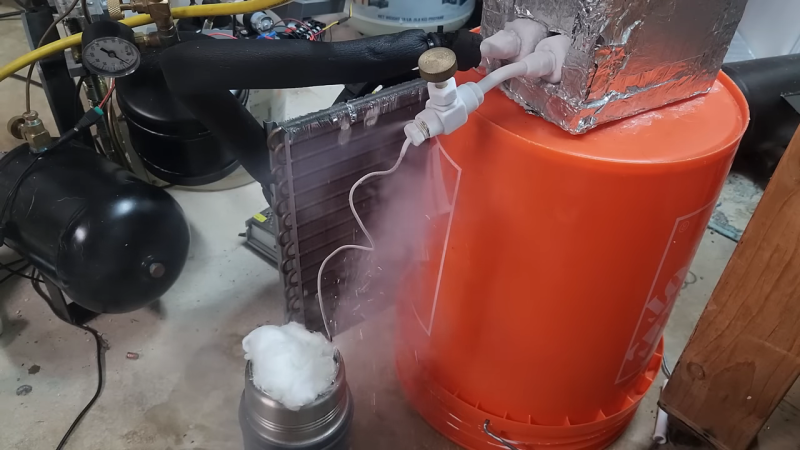[Hyperspace Pirate] wants to make his own dry ice, but he wants it to be really, really cheap. So naturally, his first stop is… the beach?
That’s right, the beach, because that’s where to find the buckets of free seashells that he turned into dry ice. Readers may recall previous efforts at DIY dry ice, which used baking soda and vinegar as a feedstock. We’d have thought those were pretty cheap materials for making carbon dioxide gas, but not cheap enough for [Hyperspace Pirate], as the dry ice he succeeded in making from them came out to almost ten bucks a pound. The low yield of the process probably had more to do with the high unit cost, in truth, so cheaper feedstocks and improved yield would attack the problem from both ends.
With a supply of zero-cost calcium carbonate from the beach and a homemade ZVS-powered induction heater tube furnace at the ready, [Hyperspace Pirate] was ready to make quicklime and capture the CO2 liberated in the process. That proved to be a little more difficult than planned since the reaction needed not just heat but a partial vacuum to drive the CO2 off. An oil-free vacuum pump helped, yielding a little CO2, but eventually he knuckled under and just doused the shells in vinegar. This had the fun side effect of creating calcium acetate, which when distilled not only corrodes the copper still plumbing but also makes a lousy but still flammable grade of acetone. Once enough CO2 was stored in a couple of beach balls, the process of cooling and condensing it into dry ice was pretty much the same as the previous method, except for taking advantage of the Joule-Thomson cryocooler he built a while back.
The result is a hundred or so grams of dry ice snow, which isn’t great but still shows promise. [Hyperspace Pirate] feels like the key to improving this process is more heat to really drive the calcination reaction. Might we suggest a DIY tube furnace for that job?

















Cool video!
Ice, ice baby.
Free?
Where is the profit then in “She sells sea shells by the sea shore”?
B^)
Moichandising! Moichandising! Moichandising! Where the real money from the movie is made!
She snags sea shells by the sea shore.
A large online former-bookseller has 50lb bags of sodium bicarbonate for $56 shipped. That’s a list a buck a pound so unless vinegar AKA dilute acetic acid is super expensive (it’s not), $10 a pound for feedstock is questionable.
I mean. I fully realize the purpose of this is to get clicks not do something particularly science but still.
I think that was $10/lb of dry ice – see the “low yield” comment.
Not science.
This is an ‘engineering exercise’ at worst.
Don’t put it down.
He is intending to make ‘dry ice bombs’?
If not, remove my endorsement.
Like I commented on the video, most of the time if you want to use calcium carbonate to isolate CO2, collecting more than a small amount of shells whether sea- or egg- is definitely the hard way. Doesn’t seem much cheaper than spending a few dollars on either limestone or a bag of lime, especially if you don’t need purity. If you start with lime you need to first cure it with atmospheric CO2 but that’s easy enough, basically do what you do for whitewash/limewash/lime plaster/etc without the need for it to properly adhere or set to a high strength or anything. Maybe sit in a tray with a fan? I can’t say I’ve tried it.
But yeah the other thing is, baking soda is normally cheaper than it was implied, and is called baking soda because it releases CO2 in a home oven. It will do it again as washing soda at a higher temperature. No need for an acid. Should be about a dollar per pound of input material?
Isn’t it not just the bizar-title-youtube-clickbait? He could just as well have added “another level”, “blew my mind”, “10 ways to…”.
Starting with apple juice and yeast would produce plenty of CO2 (for free, but slowly) and have a tasty byproduct of hard cider!
“the cheap way” involves having a vacuum pump, induction heater, and cryocooler. I’m looking for cheap as in $20 of parts and a lot of labor. Have been wanting to build a zvs induction forge, but still budgeting $100 for that.